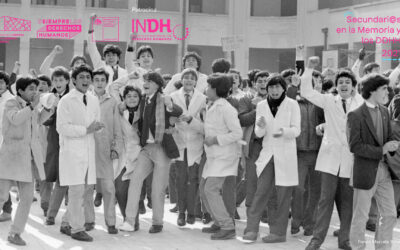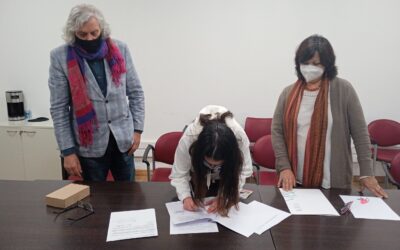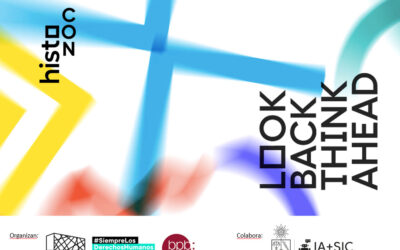Conectando personas a través de la memoria y los derechos humanos / (Connecting people through memory and human rights), es el nuevo Programa que ofrece el Museo de la Memoria y los Derechos Humanos para permitir que personas en cualquier lugar del mundo puedan conectar con la historia y actualidad chilena, en torno a la defensa de los DDHH. Por el momento estas visitas virtuales se realizan en español e inglés.
Este programa educativo ya ha sido utilizado por estudiantes de Francia, Dinamarca, México y los Estados Unidos, como los estudiantes de la prestigiosa escuela Nightingale-Bamford en Nueva York.
Para Claudio Rammsy jefe de Educación del Museo de la Memoria y los DD.HH. la idea de realizar estas visitas virtuales para colegios, universidades y organizaciones en otros países, es una instancia en la que nos hemos visto obligados dado el distanciamiento social que nos impone las medidas sanitarias a causa de la pandemia del Covid-19. Sin embargo: “lo vemos como una oportunidad única que nos permite llegar a nuestro público de manera directa, a través, del trabajo de mediación cultural que realiza el Museo”. La gran mayoría de los colegios en Chile y el Mundo está realizando clases a distancia por lo que el uso de las tecnologías en comunicación nos permite adaptarnos a las necesidades particulares de los más diversos públicos, especialmente en colegios e instituciones.
La visita virtual nos permite un espacio nuevo y neutral, a disposición del público para les permite ampliar el conocimiento en torno a los derechos humanos y memoria de Chile.
Las visitas virtuales consisten en una charla dirigida por profesionales de la educación, cultura e historia quienes, a través de video conferencia acercan las temáticas del museo a los más diversos públicos, siempre con el afán de promover los valores de los DDHH y generar una reflexión en torno a la importancia que estos tienen para nuestra sociedad actual.
Francisco San Martin, uno de los mediadores quien ha liderado este tipo intervenciones resalta el gran interés que existe a nivel internacional por conocer la memoria de Chile y su historia reciente. “Lo que hace la mediación es generar un punto de conexión de los temas que aborda el Museo de la Memoria con las inquietudes que tiene cada grupo. Previo a la visita virtual se tiene una reunión con los profesores o encargados de cada grupo para entender sus necesidades, y el enfoque que tendrá la charla, ya sea Dictadura en Chile, Violaciones a los DDHH, Estallido social, Lucha por verdad y Justicia, Cultura y Resistencia, Reparación etc.”
“El estallido social despertó un gran interés en lo que está pasando en temas de derechos humanos y cómo el Museo ha sido un ejemplo para generar una cultura mundial enfocada en el nunca más, con el fin de no repetir los errores del pasado y generar una conciencia social en torno a estas temáticas”.
Las visitas están diseñadas para colegios, universidades, organizaciones, familias, y grupos de cualquier índole interesados en conocer la muestra del Museo y su enfoque de derechos humanos, estas tienen duración de 45 a 60 minutos, los que se adapta a una clase formal. Con un límite de audiencia que no supere las 30 personas, potenciando así la conversación y las opiniones. Conectando personas a través de la Memoria y los Derechos Humanos.
*Las vistas pueden solicitarse en español y en inglés con un máximo de 30 personas por sesión, al Whatsapp: +5694291874 y se agendará una reunión previa para adaptar las materias según los requerimientos específicos del grupo.
*
Connecting people through memory and human rights / Conectando personas a través de la memoria y los Derechos humanos, is the new Program offered by the Museum of Memory and Human Rights to allow people anywhere in the world to connect with history and Chilean news, on the defense of human rights. At the moment these virtual visits are available in Spanish and English language.
This educational program has already been used by students from France, Denmark, Mexico and the US, as the students from the Prestigious Nightingale-Bamford School in NY.
For Claudio Rammsy, Head of Education at the Museum of Memory and Human Rights, the idea of making these virtual visits for schools, universities and organizations in other countries is an instance in which we have been forced given the social distancing that we It imposes the Sanitary measures imposed on us by the Covid-19 pandemic. However: “we see it as a unique opportunity that allows us to reach our audience directly through the cultural mediation work carried out by the Museum”. The vast majority of schools in Chile and the world are conducting distance classes, so the use of communication technologies allows us to adapt to the particular needs of the most diverse audiences, especially in schools and institutions.
The virtual visit allows us a new and neutral space, available to the public to broaden their knowledge of human rights and the memory of Chile.
The virtual visits consist of a talk led by professionals from education, culture and history who, through a video conference, by Zoom or Skype bring the museum’s themes to the most diverse audiences, always with the aim of promoting human rights values and generating reflection around the importance to defend these have for our current society.
Francisco San Martín, one of the mediators who has led this type of intervention, highlights the great interest that exists at the international level to know the memory of Chile and its recent history. “What mediation does is generate a connection point between the issues addressed by the Museum of Memory with the concerns that each group has. Prior to the virtual visit, a meeting is held with the teachers or those in charge of each group to understand their needs, and the focus that the talk will have, such as, Dictatorship in Chile, Human Rights Violations, Social Uprising, Fight for Truth and Justice, Culture and Resistance, Reparation etc.”
“The social uprising aroused great interest in what is happening on human rights issues and how the Museum has been an example to generate a world culture focused on Never Again, in order not to repeat the mistakes of the past and generate a social awareness around these issues ”.
The visits are designed for schools, universities, organizations, families, and groups of any kind interested in learning about the Museum’s exhibition and its approach to human rights, they last from 45 to 60 minutes, which are adapted to a formal class. With an audience limit that does not exceed 30 participants, promoting the conversation and the opinions. Connecting people through Memory and Human Rights.
*The views can be requested in Spanish and English with a maximum of 30 people per session, at WhatsApp: +5694291874 and a previous meeting will be scheduled to adapt the subjects according to the specific requirements of the group.
Volver a Noticias






